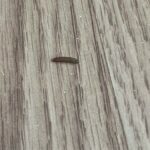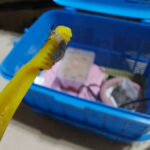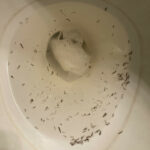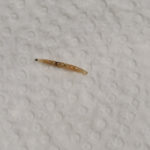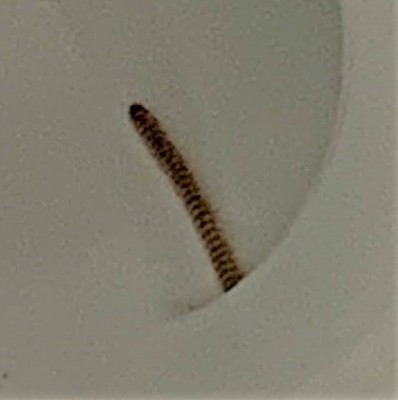
“This is really bizarre”, writes Sergio about the horde of worms he found inside a light fixture in his eight-floor apartment in Portugal. “I was recovering a room that was not used for many years. The ceiling light was out, so I dismounted the fixture and a lot of dirt was inside (possible biomass, in retrospect). I washed it all out, replaced the light bulb, mounted the fixture and I had light in that room again. A few weeks later I turned on the light and within a few minutes a worm fell from the ceiling. I discarded the worm down the toilet and didn’t think much of it until I caught movement in the light, and I found what you see in the video below. I’m sorry that I didn’t have the balls to dismount it and give a closer look but I’m kinda freaked out, especially because once I unscrew it they’ll start falling through the middle. Any idea what might be going on here? I took this video two weeks after the finding and they’re still moving once I turn on the light. I was hoping they’d die before I took it apart but it’s taking quite a while. I don’t see any opening but one fell through somehow so there should be one. Any idea what that might be? Are those larvae of something bigger or are those the final forms themselves? Is food getting in there? Are they eating each other to survive this long? Did some bug get in there and lay a bunch of eggs or is it possible that the eggs were in there the whole time and when I replaced the bulb they hatched with the heat? Can eggs survive for many years? I’m so confused. Here’s a video: https://youtube.com/shorts/1fQh6eDm1Dg”
First of all, we definitely agree with Sergio that this is an extremely odd situation, and all of his questions are completely merited. Secondly, we must agree that unscrewing the lamp from the ceiling and awaiting all the worms falling through the middle is a terrifying thought, so we do not blame him for not having the courage to do this. Perhaps, if he does want to unscrew the light to get the worms out of there, he could ask a friend to help him: one person holds a plastic bag under the light as the other person unscrews the lamp, so the worms fall into the bag, which can then be taken outside where the worms can be moved. Thirdly, we have to say that it will not be possible for us to provide an identification of these worms, as it is impossible to make out their unique characteristics through the lampshade. All we can see is that they are ‘worm-shaped’ and that they are a dark color, maybe black.
We think Sergio’s guesses as to how the worms got into the lampshade are pretty sound. We think his best guess is probably that a bug got inside the lamp and laid eggs there. After all, if there is a gap big enough for the worms to fall through, then that gap is likely big enough for a bug to squeeze through to lay eggs. And that bug probably did this because it deemed this space safe to lay its eggs. Likewise, since the gap is big enough for the worms to crawl through, and there are still so many of the creatures inside the lampshade, we would assume that these guys are newly-hatched. Otherwise we think more of them would have gotten out by now and started crawling around. To answer Sergio’s other questions, eggs cannot survive for several years, and food is likely not getting in there: even if an adult insect was bringing them food, they probably would not be able to bring enough food to feed them all without that food also being visible through the lampshade. Lastly, it is likely that these are larvae and not worms, provided that the explanation that an insect crawled into the lampshade and laid eggs is accurate. So, in this case, these are not the larvae’s “final forms”: they will eventually turn into pupae before transforming into adult insects.
To conclude, we are not sure what Sergio found in his lampshade, but they are likely insect larvae of some kind. We cannot promise if they are harmful or not, since we do not know what they are. What we suggest is that he gets the help of a friend to empty the lampshade, and that, when they do this, they wear long sleeves and long pants, as well as gloves of some kind, so as to make sure the larvae do not make contact with their skin. Despite not being able to provide an accurate identification, we hope that this article helps. We wish Sergio the best!
All About Worms is always free, always reader-supported. Your tips via CashApp, Venmo, or Paypal are appreciated! Receipts will come from ISIPP Publishing.
You might also find these guys interesting!




